
Königsberg Cathedral is a Brick Gothic-style monument in Kaliningrad, Russia, located on Kneiphof island in the Pregel (Pregolya) river. It is the most significant preserved building of the former City of Königsberg, which was largely destroyed in World War II.
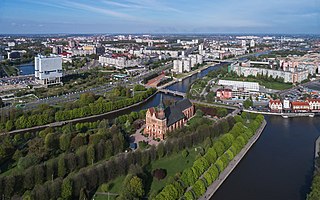
Kneiphof was a quarter of central Königsberg (Kaliningrad). During the Middle Ages it was one of the three towns that composed the city of Königsberg, the others being Altstadt and Löbenicht. The town was located on a 10-hectare (25-acre) island of the same name in the Pregel River and included Königsberg Cathedral and the original campus of the University of Königsberg. Its territory is now part of the Moskovsky District of Kaliningrad, Russia.
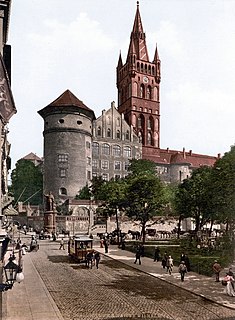
The Königsberg Castle was a castle in Königsberg, Germany, and was one of the landmarks of the East Prussian capital Königsberg.

The bombing of Königsberg was a series of attacks made on the city of Königsberg in East Prussia during World War II. The Soviet Air Force had made several raids on the city since 1941. Extensive attacks carried out by RAF Bomber Command destroyed most of the city's historic quarters in the summer of 1944. Königsberg was also heavily bombed during the Battle of Königsberg, in the final weeks of the war.
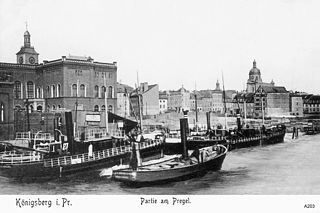
Löbenicht was a quarter of central Königsberg, Germany. During the Middle Ages it was the weakest of the three towns that composed the city of Königsberg, the others being Altstadt and Kneiphof. Its territory is now part of the Leningradsky District of Kaliningrad, Russia.

Altstadt was a quarter of central Königsberg, Germany. During the Middle Ages it was the most powerful of the three towns that composed the city of Königsberg, the others being Löbenicht and Kneiphof. Its territory is now part of Kaliningrad, Russia.

Königsberg was the historic Prussian city that is now Kaliningrad, Russia. Königsberg was founded in 1255 on the site of the ancient Old Prussian settlement Twangste by the Teutonic Knights during the Northern Crusades, and was named in honour of King Ottokar II of Bohemia. A Baltic port city, it successively became the capital of their monastic state, the Duchy of Prussia (1525–1701) and East Prussia. Königsberg remained the coronation city of the Prussian monarchy, though the capital was moved to Berlin in 1701.

Neue Sorge, also known as Königstraße or Königstrasse after its main boulevard, was a quarter of eastern Königsberg, Germany. Its territory is now part of the Leningradsky District of Kaliningrad, Russia.
Sackheim was a quarter of eastern Königsberg, Germany. Its territory is now part of the Leningradsky District of Kaliningrad, Russia.
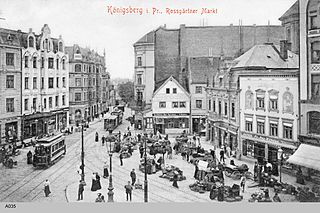
Rossgarten was a quarter of northeastern Königsberg, Germany. It was also occasionally known as Altrossgarten (Altroßgarten) to differentiate it from Neurossgarten in northwestern Königsberg. Its territory is now part of the Leningradsky District of Kaliningrad, Russia.

Burgfreiheit or Schlossfreiheit was a quarter of Königsberg, Germany. Its territory is now part of Kaliningrad, Russia.
Tragheim was a quarter of northern Königsberg, Germany. Its territory is now part of Kaliningrad, Russia.

Lastadie was a quarter of central Königsberg, Germany. Its territory is now part of Kaliningrad, Russia.
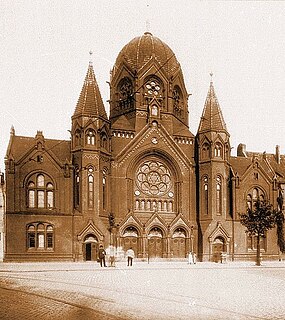
Lomse was a quarter of eastern Königsberg in Germany. Lomse was located on the western end of Lomse Island in the Pregel River; the large island is now known as October Island. The Neuer Pregel, the northern branch of the river, separated Lomse from Kneiphof to the west, Altstadt to the northwest, and Löbenicht to the north. Lomse's territory is now part of Kaliningrad's Moskovsky District and Lomse is now known as Oktyabrsky Island, in honor of the October Revolution.
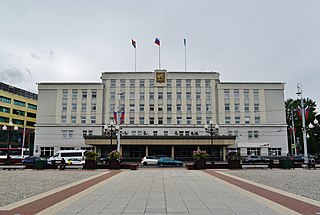
Kaliningrad City Hall is the seat of government in Kaliningrad, Russia. It is located at Victory Square.

The Kneiphof Town Hall was the town hall of insular Kneiphof, first an independent town and later a quarter of Königsberg, Germany. It served as Königsberg's city hall from 1724 to 1927, after which it became a museum until its destruction in 1944.

The Löbenicht Town Hall was the town hall of Löbenicht, first an independent town and later a quarter of Königsberg, Germany. In the 19th century it was used for newspaper printing.

Kaliningrad, until 1946 known as Königsberg, is the largest city and the administrative centre of Kaliningrad Oblast, a Russian exclave sandwiched between Lithuania and Poland. The city is situated on the Pregolya River, at the head of the Vistula Lagoon on the Baltic Sea, and is the only ice-free port of Russia and the Baltic states on the Baltic Sea. Its population in 2020 is 489,359 with up to 800,000 residents in the urban agglomeration. Kaliningrad is the second-largest city in the Northwestern Federal District, after Saint Petersburg, the third-largest city in the Baltic region, and the seventh-largest city on the Baltic Sea.

The following is a timeline of the history of the city of Kaliningrad, Russia. Prior to 1945, the city was known as Königsberg.
The Heart of the City is a long-term project aiming at the redevelopment of the historic centre of Kaliningrad, the area surrounding the former Königsberg Castle and the House of Soviets. The project implementation unit is a Non-governmental organization Urban Planning Bureau "Heart of the City", located in Kaliningrad, Russia.




















